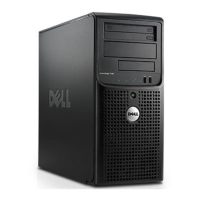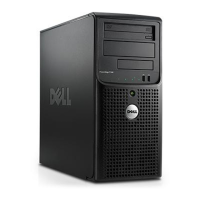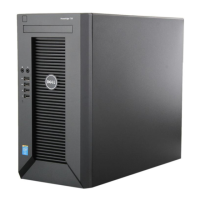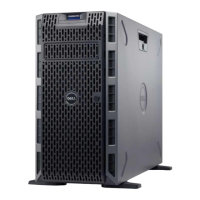Do you have a question about the Dell PowerEdge T130 and is the answer not in the manual?
Details the features and indicators on the front panel of the Dell PowerEdge T130 server.
Explains the diagnostic indicators on the front panel and their meanings during system startup.
Describes the features and indicators located on the back panel of the server.
Defines the indicator patterns for the Network Interface Card (NIC) and their meanings.
Explains the indicator codes for the power supply unit (PSU) status.
Provides a matrix of documentation resources for system setup and management.
Guides on using the Quick Resource Locator (QRL) for accessing system information.
Provides steps for unpacking, connecting, and powering on the server.
Details methods for setting up the iDRAC IP address using various interfaces.
Explains how to log in to the Integrated Dell Remote Access Controller (iDRAC).
Outlines different methods for installing the operating system on the server.
Covers remote system management using iDRAC and OpenManage software.
Recommends downloading and installing the latest BIOS, drivers, and firmware.
Explains keyboard navigation keys for accessing pre-operating system management applications.
Introduces the System Setup utility for configuring BIOS, iDRAC, and device settings.
Details the information displayed in the System Information screen within System Setup.
Details the memory settings available in System Setup for configuring memory functions.
Details processor settings for performance, virtualization, and cache management.
Details SATA settings for enabling integrated SATA controller and ports, including RAID.
Details boot settings for selecting boot mode (BIOS/UEFI) and specifying boot order.
Details network settings for PXE device configuration, available in UEFI boot mode.
Details iSCSI settings for configuring iSCSI devices, available in UEFI boot mode.
Details settings for integrated devices like video controller, RAID, and USB ports.
Details serial communication port properties and settings.
Details system profile settings for performance and power management.
Details system security settings like passwords, TPM, and Intel TXT.
Details Secure Boot custom policy settings for platform and signature databases.
Details settings for system time, date, asset tag, and keyboard NumLock.
Introduces the Boot Manager for adding, deleting, and arranging boot options.
Explains how to select the system boot mode (BIOS or UEFI) for OS installation.
Provides steps to create system and setup passwords for security.
Explains how to use the system password to secure the system after setup.
Details procedures for deleting or changing system and setup passwords.
Describes behavior when a setup password is enabled and password entry requirements.
Introduces Dell Lifecycle Controller for embedded system management.
Explains the iDRAC settings utility for configuring iDRAC parameters via UEFI.
Provides steps to access the iDRAC Settings utility.
Guides on customizing thermal control settings using the iDRAC utility.
Provides essential safety warnings and precautions before working inside the system.
Lists prerequisites and steps to follow before performing internal system maintenance.
Lists steps to perform after completing internal system maintenance.
Lists the tools recommended for performing installation and removal procedures.
Details procedures for removing and installing the system cover.
Provides step-by-step instructions for removing the system cover.
Provides step-by-step instructions for installing the system cover.
Details procedures for removing and installing the front bezel.
Provides step-by-step instructions for removing the front bezel.
Provides step-by-step instructions for installing the front bezel.
Provides a diagram illustrating the internal components of the system.
Details procedures for removing and installing the intrusion switch.
Provides step-by-step instructions for removing the intrusion switch.
Provides step-by-step instructions for installing the intrusion switch.
Details procedures for removing and installing the control panel assembly.
Provides step-by-step instructions for removing the control panel assembly.
Provides step-by-step instructions for installing the control panel assembly.
Provides information about supported hard drives and their types.
Provides step-by-step instructions for removing the hard drive cage.
Provides step-by-step instructions for installing the hard drive cage.
Provides steps to remove a hard drive carrier from the hard drive cage.
Provides steps to install a hard drive carrier into the hard drive cage.
Provides steps to remove a hard drive carrier from the hard drive bay.
Provides steps to install a hard drive carrier into the hard drive bay.
Provides steps to remove a hard drive from its carrier.
Provides steps to install a hard drive into its carrier.
Illustrates cabling diagrams for optical and hard drives connected to the PERC card.
Guides on adjusting cooling fan speed for 4 TB hard drives when using a PERC controller.
Details procedures for removing and installing the optical drive and its components.
Provides steps to remove the optical drive blank and filler from the bezel/cage.
Provides step-by-step instructions for removing the optical drive.
Provides step-by-step instructions for installing the optical drive.
Provides information on system memory support and specifications.
Illustrates the memory socket locations on the system board.
Provides guidelines for installing memory modules for optimal performance.
Shows sample memory configurations for a single processor setup.
Provides step-by-step instructions for removing memory modules.
Provides step-by-step instructions for installing memory modules.
Provides information on the system's single cooling fan.
Provides step-by-step instructions for removing the cooling fan.
Provides step-by-step instructions for installing the cooling fan.
Details the use of an internal USB memory key as a boot device or security key.
Provides steps for replacing the internal USB memory key.
Provides information on supported PCIe Gen3 expansion cards.
Guides for installing expansion cards considering cooling and mechanical fit.
Provides step-by-step instructions for removing an expansion card.
Provides step-by-step instructions for installing an expansion card.
Details the iDRAC port card, its features, and the SD vFlash card.
Provides steps for replacing the SD vFlash card in the iDRAC port card.
Provides step-by-step instructions for removing the optional iDRAC port card.
Provides step-by-step instructions for installing the optional iDRAC port card.
Provides step-by-step instructions for removing the processor heat sink.
Provides step-by-step instructions for installing the processor heat sink.
Provides step-by-step instructions for removing the processor.
Provides step-by-step instructions for installing the processor.
Provides step-by-step instructions for removing the power supply unit (PSU).
Provides step-by-step instructions for installing the power supply unit (PSU).
Provides step-by-step instructions for replacing the system battery.
Provides step-by-step instructions for removing the system board.
Provides step-by-step instructions for installing the system board.
Guides on entering the system service tag via System Setup.
Details the function and importance of the Trusted Platform Module (TPM).
Provides step-by-step instructions for installing the Trusted Platform Module (TPM).
Guides on re-enabling the TPM for users utilizing BitLocker encryption.
Guides on re-enabling the TPM for users utilizing TXT technology.
Emphasizes safety precautions for performing troubleshooting on the system.
Provides guidance on resolving system startup failures.
Guides on troubleshooting issues related to external cable connections.
Provides steps for troubleshooting video subsystem issues.
Provides steps for troubleshooting issues with USB devices.
Provides steps for troubleshooting issues with serial I/O devices.
Provides steps for troubleshooting Network Interface Card (NIC) issues.
Provides guidance on troubleshooting a system exposed to moisture.
Provides steps for troubleshooting a system that may have physical damage.
Provides steps for troubleshooting issues related to the system battery.
Provides guidance on troubleshooting power supply unit (PSU) issues.
Guides on troubleshooting issues with the system's power source.
Provides steps for troubleshooting system cooling issues.
Provides steps for troubleshooting issues with cooling fans.
Provides steps for troubleshooting system memory issues.
Provides steps for troubleshooting issues with an internal USB key.
Provides steps for troubleshooting issues with an SD card.
Provides steps for troubleshooting issues with the optical drive.
Provides steps for troubleshooting hard drive issues.
Provides steps for troubleshooting storage controller issues.
Provides steps for troubleshooting issues with expansion cards.
Provides steps for troubleshooting processor issues.
Explains system messages generated by firmware and agents.
Describes warning messages and how to respond to them.
Explains diagnostic messages that may appear during system diagnostics.
Describes alert messages generated by systems management software.
Introduces Dell Embedded System Diagnostics (ePSA) for system testing.
Advises when to use the Embedded System Diagnostics, such as when the system does not boot.
Provides steps to run diagnostics from the Boot Manager.
Provides steps to run diagnostics from the Dell Lifecycle Controller.
Explains the controls available within the system diagnostics interface.
Illustrates and describes system board jumpers and connectors.
Details the settings and functions of system board jumpers like PWRD_EN and NVRAM_CLR.
Provides steps to disable a forgotten system or setup password using a jumper.
Lists the physical dimensions and weight of the server.
Lists the specifications for the processor used in the system.
Details the specifications for the PCIe Gen3 expansion slots.
Lists the specifications for system memory, including type and capacities.
Details the power supply unit specifications, including rating and voltage.
Lists the supported storage controller types.
Lists the specifications for supported hard drives and optical drives.
Details the specifications for the server's back and front connectors.
Lists the specifications for the integrated video controller.
Lists environmental operating conditions for temperature, humidity, and vibration.
Provides information on how to contact Dell for support and service options.
Explains how to find the system's unique Service Tag for support purposes.
Details the features and indicators on the front panel of the Dell PowerEdge T130 server.
Explains the diagnostic indicators on the front panel and their meanings during system startup.
Describes the features and indicators located on the back panel of the server.
Defines the indicator patterns for the Network Interface Card (NIC) and their meanings.
Explains the indicator codes for the power supply unit (PSU) status.
Provides a matrix of documentation resources for system setup and management.
Guides on using the Quick Resource Locator (QRL) for accessing system information.
Provides steps for unpacking, connecting, and powering on the server.
Details methods for setting up the iDRAC IP address using various interfaces.
Explains how to log in to the Integrated Dell Remote Access Controller (iDRAC).
Outlines different methods for installing the operating system on the server.
Covers remote system management using iDRAC and OpenManage software.
Recommends downloading and installing the latest BIOS, drivers, and firmware.
Explains keyboard navigation keys for accessing pre-operating system management applications.
Introduces the System Setup utility for configuring BIOS, iDRAC, and device settings.
Details the information displayed in the System Information screen within System Setup.
Details the memory settings available in System Setup for configuring memory functions.
Details processor settings for performance, virtualization, and cache management.
Details SATA settings for enabling integrated SATA controller and ports, including RAID.
Details boot settings for selecting boot mode (BIOS/UEFI) and specifying boot order.
Details network settings for PXE device configuration, available in UEFI boot mode.
Details iSCSI settings for configuring iSCSI devices, available in UEFI boot mode.
Details settings for integrated devices like video controller, RAID, and USB ports.
Details serial communication port properties and settings.
Details system profile settings for performance and power management.
Details system security settings like passwords, TPM, and Intel TXT.
Details Secure Boot custom policy settings for platform and signature databases.
Details settings for system time, date, asset tag, and keyboard NumLock.
Introduces the Boot Manager for adding, deleting, and arranging boot options.
Explains how to select the system boot mode (BIOS or UEFI) for OS installation.
Provides steps to create system and setup passwords for security.
Explains how to use the system password to secure the system after setup.
Details procedures for deleting or changing system and setup passwords.
Describes behavior when a setup password is enabled and password entry requirements.
Introduces Dell Lifecycle Controller for embedded system management.
Explains the iDRAC settings utility for configuring iDRAC parameters via UEFI.
Provides steps to access the iDRAC Settings utility.
Guides on customizing thermal control settings using the iDRAC utility.
Provides essential safety warnings and precautions before working inside the system.
Lists prerequisites and steps to follow before performing internal system maintenance.
Lists steps to perform after completing internal system maintenance.
Lists the tools recommended for performing installation and removal procedures.
Details procedures for removing and installing the system cover.
Provides step-by-step instructions for removing the system cover.
Provides step-by-step instructions for installing the system cover.
Details procedures for removing and installing the front bezel.
Provides step-by-step instructions for removing the front bezel.
Provides step-by-step instructions for installing the front bezel.
Provides a diagram illustrating the internal components of the system.
Details procedures for removing and installing the intrusion switch.
Provides step-by-step instructions for removing the intrusion switch.
Provides step-by-step instructions for installing the intrusion switch.
Details procedures for removing and installing the control panel assembly.
Provides step-by-step instructions for removing the control panel assembly.
Provides step-by-step instructions for installing the control panel assembly.
Provides information about supported hard drives and their types.
Provides step-by-step instructions for removing the hard drive cage.
Provides step-by-step instructions for installing the hard drive cage.
Provides steps to remove a hard drive carrier from the hard drive cage.
Provides steps to install a hard drive carrier into the hard drive cage.
Provides steps to remove a hard drive carrier from the hard drive bay.
Provides steps to install a hard drive carrier into the hard drive bay.
Provides steps to remove a hard drive from its carrier.
Provides steps to install a hard drive into its carrier.
Illustrates cabling diagrams for optical and hard drives connected to the PERC card.
Guides on adjusting cooling fan speed for 4 TB hard drives when using a PERC controller.
Details procedures for removing and installing the optical drive and its components.
Provides steps to remove the optical drive blank and filler from the bezel/cage.
Provides step-by-step instructions for removing the optical drive.
Provides step-by-step instructions for installing the optical drive.
Provides information on system memory support and specifications.
Illustrates the memory socket locations on the system board.
Provides guidelines for installing memory modules for optimal performance.
Shows sample memory configurations for a single processor setup.
Provides step-by-step instructions for removing memory modules.
Provides step-by-step instructions for installing memory modules.
Provides information on the system's single cooling fan.
Provides step-by-step instructions for removing the cooling fan.
Provides step-by-step instructions for installing the cooling fan.
Details the use of an internal USB memory key as a boot device or security key.
Provides steps for replacing the internal USB memory key.
Provides information on supported PCIe Gen3 expansion cards.
Guides for installing expansion cards considering cooling and mechanical fit.
Provides step-by-step instructions for removing an expansion card.
Provides step-by-step instructions for installing an expansion card.
Details the iDRAC port card, its features, and the SD vFlash card.
Provides steps for replacing the SD vFlash card in the iDRAC port card.
Provides step-by-step instructions for removing the optional iDRAC port card.
Provides step-by-step instructions for installing the optional iDRAC port card.
Provides step-by-step instructions for removing the processor heat sink.
Provides step-by-step instructions for installing the processor heat sink.
Provides step-by-step instructions for removing the processor.
Provides step-by-step instructions for installing the processor.
Provides step-by-step instructions for removing the power supply unit (PSU).
Provides step-by-step instructions for installing the power supply unit (PSU).
Provides step-by-step instructions for replacing the system battery.
Provides step-by-step instructions for removing the system board.
Provides step-by-step instructions for installing the system board.
Guides on entering the system service tag via System Setup.
Details the function and importance of the Trusted Platform Module (TPM).
Provides step-by-step instructions for installing the Trusted Platform Module (TPM).
Guides on re-enabling the TPM for users utilizing BitLocker encryption.
Guides on re-enabling the TPM for users utilizing TXT technology.
Emphasizes safety precautions for performing troubleshooting on the system.
Provides guidance on resolving system startup failures.
Guides on troubleshooting issues related to external cable connections.
Provides steps for troubleshooting video subsystem issues.
Provides steps for troubleshooting issues with USB devices.
Provides steps for troubleshooting issues with serial I/O devices.
Provides steps for troubleshooting Network Interface Card (NIC) issues.
Provides guidance on troubleshooting a system exposed to moisture.
Provides steps for troubleshooting a system that may have physical damage.
Provides steps for troubleshooting issues related to the system battery.
Provides guidance on troubleshooting power supply unit (PSU) issues.
Guides on troubleshooting issues with the system's power source.
Provides steps for troubleshooting system cooling issues.
Provides steps for troubleshooting issues with cooling fans.
Provides steps for troubleshooting system memory issues.
Provides steps for troubleshooting issues with an internal USB key.
Provides steps for troubleshooting issues with an SD card.
Provides steps for troubleshooting issues with the optical drive.
Provides steps for troubleshooting hard drive issues.
Provides steps for troubleshooting storage controller issues.
Provides steps for troubleshooting issues with expansion cards.
Provides steps for troubleshooting processor issues.
Explains system messages generated by firmware and agents.
Describes warning messages and how to respond to them.
Explains diagnostic messages that may appear during system diagnostics.
Describes alert messages generated by systems management software.
Introduces Dell Embedded System Diagnostics (ePSA) for system testing.
Advises when to use the Embedded System Diagnostics, such as when the system does not boot.
Provides steps to run diagnostics from the Boot Manager.
Provides steps to run diagnostics from the Dell Lifecycle Controller.
Explains the controls available within the system diagnostics interface.
Illustrates and describes system board jumpers and connectors.
Details the settings and functions of system board jumpers like PWRD_EN and NVRAM_CLR.
Provides steps to disable a forgotten system or setup password using a jumper.
Lists the physical dimensions and weight of the server.
Lists the specifications for the processor used in the system.
Details the specifications for the PCIe Gen3 expansion slots.
Lists the specifications for system memory, including type and capacities.
Details the power supply unit specifications, including rating and voltage.
Lists the supported storage controller types.
Lists the specifications for supported hard drives and optical drives.
Details the specifications for the server's back and front connectors.
Lists the specifications for the integrated video controller.
Lists environmental operating conditions for temperature, humidity, and vibration.
Provides information on how to contact Dell for support and service options.
Explains how to find the system's unique Service Tag for support purposes.
| Memory slots | 4 |
|---|---|
| Internal memory | 8 GB |
| Memory clock speed | 2133 MHz |
| Internal memory type | DDR4-SDRAM |
| Maximum internal memory | 64 GB |
| HDD size | 3.5 \ |
| HDD speed | 7200 RPM |
| HDD capacity | 1000 GB |
| RAID support | No |
| HDD interface | Serial ATA III |
| Optical drive type | DVD±RW |
| Total storage capacity | 2000 GB |
| Maximum storage capacity | - TB |
| Number of HDDs installed | 2 |
| Supported storage drive interfaces | SAS, Serial ATA |
| Bus type | QPI |
| Stepping | R0 |
| Tjunction | - °C |
| Idle States | Yes |
| Scalability | 1S |
| Processor code | SR2LG |
| Processor cache | 8 MB |
| Processor model | E3-1220V5 |
| System bus rate | 8 GT/s |
| Processor series | Intel Xeon E3-1200 v5 |
| Processor socket | LGA 1151 (Socket H4) |
| Processor codename | Skylake |
| Number of QPI links | - |
| Processor frequency | 3 GHz |
| Processor cache type | Smart Cache |
| Configurable TDP-down | - W |
| Processor lithography | 14 nm |
| Processor manufacturer | Intel |
| Processor package size | 37.5 x 37.5 mm |
| Processor boost frequency | 3.5 GHz |
| Processor operating modes | 64-bit |
| PCI Express configurations | 1x16, 1x8+2x4, 2x8 |
| Supported instruction sets | AVX 2.0, SSE4.1, SSE4.2 |
| Thermal Design Power (TDP) | 80 W |
| Number of processors installed | 1 |
| Maximum number of PCI Express lanes | 16 |
| Memory types supported by processor | DDR3L-SDRAM, DDR4-SDRAM |
| Memory voltage supported by processor | 1.35 V |
| Memory channels supported by processor | Dual |
| Memory clock speeds supported by processor | 1333, 1600, 1866, 2133 MHz |
| Memory bandwidth supported by processor (max) | 34.1 GB/s |
| Cabling technology | 10/100/1000Base-T(X) |
| Ethernet interface type | Gigabit Ethernet |
| USB 2.0 ports quantity | 5 |
| USB 3.2 Gen 1 (3.1 Gen 1) Type-A ports quantity | 3 |
| Chassis type | Mini Tower |
| On-board graphics card model | Not available |
| Number of displays supported (on-board graphics) | 0 |
| Processor ARK ID | 88172 |
| Intel Secure Key Technology version | 1.00 |
| PCI Express slots version | 3.0 |
| Power supply | 290 W |
| Depth | 435 mm |
|---|---|
| Width | 175 mm |
| Height | 360 mm |











